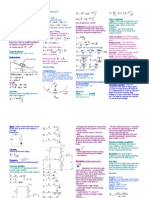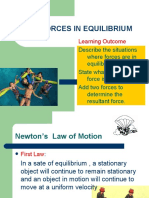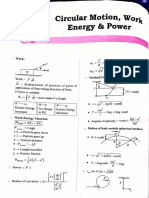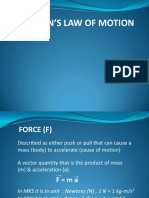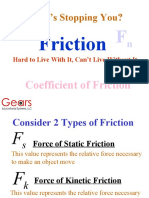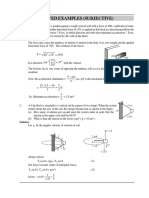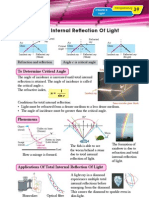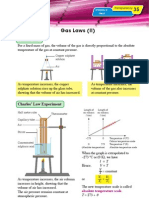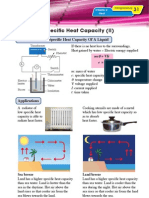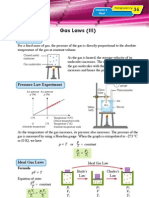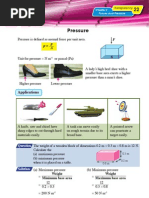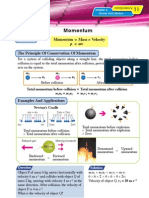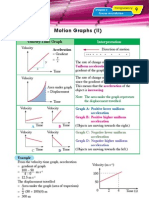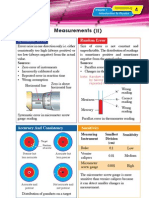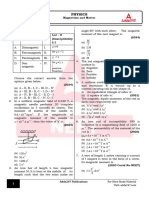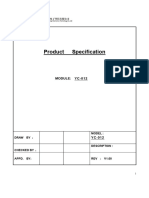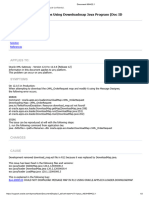Pdfa2 11
Pdfa2 11
Uploaded by
aizatCopyright:
Available Formats
Pdfa2 11
Pdfa2 11
Uploaded by
aizatOriginal Title
Copyright
Available Formats
Share this document
Did you find this document useful?
Is this content inappropriate?
Copyright:
Available Formats
Pdfa2 11
Pdfa2 11
Uploaded by
aizatCopyright:
Available Formats
Chapter 2
Transparency
16
Forces And Motion
Forces In Equilibrium
Newtonʼs Third Law Of Motion
For every action, there is an equal and opposite reaction.
R
Normal reaction = Weight R = mg
Wooden block
R = mg Table (Stationary)
Wooden block is not moving, resultant force = 0
Wooden block is in equilibrium. mg
Wooden block
R = mg R (Moves with
Frictional uniform velocity)
F1 = F2 force
Wooden block is moving with uniform velocity, F2 Pulling
force
∴ Resultant force = 0 Table F1
Wooden block is in equilibrium. mg F1 = F2
R (Stationary)
R = mg cos θ
F
F = mg sin θ Frictional force
Wooden block is not moving. mg sin θ
∴ Resultant force = 0 mg cos θ
θ
Wooden block is in equilibrium.
R Wooden block
R = mg (Moves with acceleration)
Smooth
Wooden block is moving with acceleration a. Table Pulling
force
∴ Resultant force F = ma
F
Wooden block is not in equilibrium. mg
Parallelogram Of Forces Resolution Of Forces
The resultant of two forces F1 and The resultant force F can be resolved into
F2 is the force F, represented by the a vertical component force F sin θ and a
diagonal of the parallelogram. horizontal component force F cos θ.
(Resultant force)
F sin θ F
F1 F (Vertical
component) θ
F2 F cos θ
(Horizontal component)
© Marshall Cavendish ( Malaysia ) Sdn. Bhd.
You might also like
- Concept Design Report Mahanakhon Building PDFDocument85 pagesConcept Design Report Mahanakhon Building PDFBruno Daniel Castro Oliveira75% (8)
- 6th Central Pay Commission Salary CalculatorDocument15 pages6th Central Pay Commission Salary Calculatorrakhonde100% (436)
- 6th Central Pay Commission Salary CalculatorDocument15 pages6th Central Pay Commission Salary Calculatorrakhonde100% (436)
- Physics Cheatsheet Unit 3 Ver.3Document3 pagesPhysics Cheatsheet Unit 3 Ver.3Hung TranNo ratings yet
- 2.9 Forces in Equilibrium: Learning OutcomeDocument25 pages2.9 Forces in Equilibrium: Learning OutcomekhodijahaminNo ratings yet
- Bahan Untuk Leraian Daya t5Document18 pagesBahan Untuk Leraian Daya t5KRISHNAMURTHY A/L SUBRAMANIAM MoeNo ratings yet
- Structural Formulas ReviewerDocument29 pagesStructural Formulas ReviewerisaacalvareztejanoNo ratings yet
- Structural FormulasDocument29 pagesStructural FormulasBernard de VeraNo ratings yet
- Lecture 1 Forces, Stress and StrainDocument40 pagesLecture 1 Forces, Stress and StrainKeran DiasNo ratings yet
- PHYS101 Laws of MotionDocument53 pagesPHYS101 Laws of MotionCoolman TatsuNo ratings yet
- Eng 0202 Force StudDocument136 pagesEng 0202 Force StudSally ThamNo ratings yet
- Structural FormulasDocument29 pagesStructural Formulaskevin John EstilloreNo ratings yet
- Chapter 4 Force and Motion (II) : Addition and Resolution of ForcesDocument10 pagesChapter 4 Force and Motion (II) : Addition and Resolution of ForcesZhu JiankunNo ratings yet
- PHYS101 - Laws of MotionDocument53 pagesPHYS101 - Laws of MotionSamuel ArquilloNo ratings yet
- FrictionDocument8 pagesFrictiontoxicjjNo ratings yet
- Determinacy, Indeterminacy & Stability of Structure: Civil Booster (Civil Ki Goli Publication 9255624029)Document10 pagesDeterminacy, Indeterminacy & Stability of Structure: Civil Booster (Civil Ki Goli Publication 9255624029)ramesh sitaulaNo ratings yet
- First Condition of Equilibrium (Fce)Document22 pagesFirst Condition of Equilibrium (Fce)Miggy IsbertoNo ratings yet
- Rectangular Components of ForceDocument6 pagesRectangular Components of ForceAgri EngNo ratings yet
- Law of Friction: Surface Between Two Bodies Oppose Relative MotionDocument11 pagesLaw of Friction: Surface Between Two Bodies Oppose Relative MotioneltytanNo ratings yet
- Normal forces.Document1 pageNormal forces.wbmrd8xpnhNo ratings yet
- 5 Moment of A Force: Practice 5.1 (p.185)Document6 pages5 Moment of A Force: Practice 5.1 (p.185)Andy HungNo ratings yet
- Circular Motion, Work Energy and PowerDocument14 pagesCircular Motion, Work Energy and Powersinghkushagra2402No ratings yet
- Revision Exercise 4: Cocept Traps (p.169)Document6 pagesRevision Exercise 4: Cocept Traps (p.169)4C 32 WONG SHU HANGNo ratings yet
- Q2 Genphysics1 ReviewerDocument11 pagesQ2 Genphysics1 ReviewerRhonavie RangasaNo ratings yet
- Phys12 c02 2 3Document7 pagesPhys12 c02 2 3HammadJavaid ConceptNo ratings yet
- Lecture 2 (Second Part Harmonic Motion)Document17 pagesLecture 2 (Second Part Harmonic Motion)gianfrancogiannoni4No ratings yet
- I-2.2 Statics - 13 Feb 2019Document32 pagesI-2.2 Statics - 13 Feb 2019jerryylw012No ratings yet
- Phy10t3fce&nslm PDFDocument54 pagesPhy10t3fce&nslm PDFRyan Jhay YangNo ratings yet
- Engineering Mechanics FormulasDocument5 pagesEngineering Mechanics FormulasMelvin SanteNo ratings yet
- Dry FrictionDocument14 pagesDry FrictionÂn VõNo ratings yet
- Mass Weight: QuantityDocument18 pagesMass Weight: QuantityraajNo ratings yet
- Chapter 5 ForcesDocument47 pagesChapter 5 Forcesjibankarmaker02No ratings yet
- Soeit CGB Cie1001 Chap5 w2016Document55 pagesSoeit CGB Cie1001 Chap5 w2016rashmarsvNo ratings yet
- CE1000 - L2 (August 23) PDFDocument39 pagesCE1000 - L2 (August 23) PDFk33884019No ratings yet
- FrictionDocument6 pagesFrictionElle HeartfiliaNo ratings yet
- CH 2 - Statically Determinated BeamDocument19 pagesCH 2 - Statically Determinated Beampheakdey phuongNo ratings yet
- Chapter 12 APDocument9 pagesChapter 12 APshahida.jasmineNo ratings yet
- 05 Work EnergyDocument60 pages05 Work EnergyAshwin KushwahaNo ratings yet
- B3 Force and Motion (I)Document27 pagesB3 Force and Motion (I)Ki Ki WongNo ratings yet
- A Level Mechanics 6 Forces and Friction123Document1 pageA Level Mechanics 6 Forces and Friction1232338418702qqNo ratings yet
- F Q (VXB) : Which Means That A Moving Charge in A Magnetic Field Experiences ForceDocument13 pagesF Q (VXB) : Which Means That A Moving Charge in A Magnetic Field Experiences ForceJinshy VinodNo ratings yet
- Force 8Document20 pagesForce 8Liana Belle0% (1)
- 6548b9acf0d955001809c89f - ## - Newton's Law of Motion - Short Notes - Yakeen NEET 2024Document1 page6548b9acf0d955001809c89f - ## - Newton's Law of Motion - Short Notes - Yakeen NEET 2024hr825023No ratings yet
- Work, Power and Energy: JeeprogressDocument46 pagesWork, Power and Energy: JeeprogressRahul KumarNo ratings yet
- Friction Rev 2Document14 pagesFriction Rev 2turki908No ratings yet
- LOM-03 - Subjective SolvedDocument13 pagesLOM-03 - Subjective SolvedRaju SinghNo ratings yet
- A Force Is A Push or Pull Experienced by An Object. There Are 2 Types of ForcesDocument22 pagesA Force Is A Push or Pull Experienced by An Object. There Are 2 Types of ForcesKwandile GamedeNo ratings yet
- 4 NLMDocument2 pages4 NLMdivinegaming9955No ratings yet
- FrictionDocument22 pagesFrictionJainam JaganiNo ratings yet
- FrictionDocument6 pagesFrictionJake BennettNo ratings yet
- Laws of Motion FrictionDocument4 pagesLaws of Motion Frictionrajputraghav777No ratings yet
- Concept of Force: Notation: The Force Acting On Body 1 Due To TheDocument7 pagesConcept of Force: Notation: The Force Acting On Body 1 Due To TheSpandan PandaNo ratings yet
- GravitationDocument16 pagesGravitationrajesh kumarNo ratings yet
- Chapter 2 Kinetics of ParticlesDocument30 pagesChapter 2 Kinetics of Particles2021839932No ratings yet
- m1 Work Power EnergyDocument16 pagesm1 Work Power EnergyAbidManNo ratings yet
- Revision Exercise 3: Concept Traps (p.137)Document8 pagesRevision Exercise 3: Concept Traps (p.137)4C 32 WONG SHU HANGNo ratings yet
- Module 5: Equilibrium of Two Dimensional Coplanar Forces TopicsDocument8 pagesModule 5: Equilibrium of Two Dimensional Coplanar Forces TopicsBeverly Ann GonzalesNo ratings yet
- Unit 02Document25 pagesUnit 02N.Shiney JosephNo ratings yet
- 2019 - Kuliah 7 Kasus DinamikaDocument19 pages2019 - Kuliah 7 Kasus DinamikaHafizh LuthfiNo ratings yet
- 10 - Work-Energy Methods 19-20Document72 pages10 - Work-Energy Methods 19-20Basel HeshamNo ratings yet
- 2 Newton LawDocument133 pages2 Newton Lawhi hiNo ratings yet
- Lesson No.7.Lecture - Physics For Engineers - Work.may2023-1Document1 pageLesson No.7.Lecture - Physics For Engineers - Work.may2023-1Lloyd Christian PorlajeNo ratings yet
- Pdfa5 3Document1 pagePdfa5 3aizatNo ratings yet
- Pdfa4 7Document1 pagePdfa4 7aizatNo ratings yet
- Pdfa5 2Document1 pagePdfa5 2aizatNo ratings yet
- Pdfa4 6Document1 pagePdfa4 6aizatNo ratings yet
- Pdfa4 5Document1 pagePdfa4 5aizatNo ratings yet
- Pdfa4 3Document1 pagePdfa4 3aizatNo ratings yet
- Pdfa4 8Document1 pagePdfa4 8aizatNo ratings yet
- Pdfa4 1Document1 pagePdfa4 1aizatNo ratings yet
- Pdfa3 5Document1 pagePdfa3 5aizatNo ratings yet
- Pdfa3 1Document1 pagePdfa3 1aizatNo ratings yet
- Specific Latent Heat (I) : Heating Ice To Form VapourDocument1 pageSpecific Latent Heat (I) : Heating Ice To Form VapouraizatNo ratings yet
- Pdfa2 9Document1 pagePdfa2 9aizat100% (1)
- Pdfa3 3Document1 pagePdfa3 3aizatNo ratings yet
- Pdfa3 7Document1 pagePdfa3 7aizatNo ratings yet
- Pdfa2 5Document1 pagePdfa2 5aizatNo ratings yet
- Pdfa3 2Document1 pagePdfa3 2aizatNo ratings yet
- Pdfa2 16Document1 pagePdfa2 16aizat100% (1)
- Pdfa2 6Document1 pagePdfa2 6aizatNo ratings yet
- Pdfa2 14Document1 pagePdfa2 14aizatNo ratings yet
- Pdfa2 12Document1 pagePdfa2 12aizatNo ratings yet
- Pdfa2 13Document1 pagePdfa2 13aizatNo ratings yet
- Pdfa2 8Document1 pagePdfa2 8aizatNo ratings yet
- Pdfa2 7Document1 pagePdfa2 7aizatNo ratings yet
- Pdfa2 1Document1 pagePdfa2 1aizatNo ratings yet
- Pdfa2 4Document1 pagePdfa2 4aizatNo ratings yet
- Pdfa2 3Document1 pagePdfa2 3aizatNo ratings yet
- Pdfa1 4Document1 pagePdfa1 4aizatNo ratings yet
- Pdfa1 5Document1 pagePdfa1 5aizat100% (1)
- Intraocular Pressure: Harry Murgatroyd BSC MB CHB (Hons) Jane Bembridge MB CHB (Hons) FrcaDocument4 pagesIntraocular Pressure: Harry Murgatroyd BSC MB CHB (Hons) Jane Bembridge MB CHB (Hons) FrcaArmitha Putri NapitupuluNo ratings yet
- ASPNET 4 SecurityExtensibilityDocument23 pagesASPNET 4 SecurityExtensibilityzohebdhuka_libraNo ratings yet
- TelnetDocument13 pagesTelnetJilu P Joseph BCA 17-20No ratings yet
- Yamaha RX v596 HTR 5250 RX v596rdsDocument76 pagesYamaha RX v596 HTR 5250 RX v596rdsFiliberto CaraballoNo ratings yet
- Staining TechniqueDocument2 pagesStaining TechniqueClaire MayNo ratings yet
- Physics PYQs (Part 3) (2024) From Magnetism and MatterDocument95 pagesPhysics PYQs (Part 3) (2024) From Magnetism and Matterayush.mishraNo ratings yet
- File Handling AssignmentsDocument5 pagesFile Handling Assignmentschandni19720% (1)
- Multiple Choice Questions / Practice Test Electrical Circuits - Set 4Document8 pagesMultiple Choice Questions / Practice Test Electrical Circuits - Set 4reniel fabroNo ratings yet
- BRC-Transport-Level SecurityDocument40 pagesBRC-Transport-Level SecurityanshulNo ratings yet
- HFM Tips and TricksDocument50 pagesHFM Tips and TricksAparna Paladugu100% (1)
- WinCE BoardDocument30 pagesWinCE BoardPrestige FixNo ratings yet
- 6 DecimalsDocument5 pages6 DecimalsSAMMITTRA A/P RAMESHNo ratings yet
- Introduction To ProteusDocument8 pagesIntroduction To ProteusateeqshaheenNo ratings yet
- Especificaciones Tecnicas SentryumDocument42 pagesEspecificaciones Tecnicas SentryumJuan Mansilla IsidroNo ratings yet
- Standard Test Method For Leaks Using UltrasonicsDocument4 pagesStandard Test Method For Leaks Using UltrasonicsRaphael UwazuruonyeNo ratings yet
- Space Robotics: Seminar OnDocument30 pagesSpace Robotics: Seminar OnDhanish Dhanish100% (1)
- Brown Chapter 4 - Size ReductionDocument23 pagesBrown Chapter 4 - Size ReductionhasnaNo ratings yet
- Alessio Plebe, Giorgio Grasso - The Unbearable Shallow Understanding of Deep LearningDocument39 pagesAlessio Plebe, Giorgio Grasso - The Unbearable Shallow Understanding of Deep LearningJOSÉ RODRIGO GARCÍA GONZALESNo ratings yet
- Application of Business Mathematics in The Field of Management & EconomicsDocument3 pagesApplication of Business Mathematics in The Field of Management & EconomicsSamiul Islam0% (2)
- 1-Introduction To CE352ADocument6 pages1-Introduction To CE352AshubhamNo ratings yet
- To Study of Employee Welfare Facilities 3Document14 pagesTo Study of Employee Welfare Facilities 3Vishal PatilNo ratings yet
- Document 854422.1Document2 pagesDocument 854422.1ho.caroline112No ratings yet
- How To Clean Your ComputerDocument20 pagesHow To Clean Your ComputerAndrea De MarcoNo ratings yet
- Hvac AssignmentDocument27 pagesHvac AssignmentChethan. M.D.100% (2)
- Road Force Elite at A GlanceDocument16 pagesRoad Force Elite at A GlanceicaretooNo ratings yet
- Activity 2 - Pumps - Me 423 - No AnsDocument2 pagesActivity 2 - Pumps - Me 423 - No AnsMahusay Neil DominicNo ratings yet
- Skinner (1950) - Are Theories of Learning NecessaryDocument28 pagesSkinner (1950) - Are Theories of Learning NecessaryMariza CabralNo ratings yet
- Shopper 1 Shopper 2 Shopper 3 Shopper 4 Shopper 5 Shopper 6Document10 pagesShopper 1 Shopper 2 Shopper 3 Shopper 4 Shopper 5 Shopper 6Firas BarrajNo ratings yet
- DLL Mathematics 6 q3 w5Document8 pagesDLL Mathematics 6 q3 w5Dagoc Wil Jr.No ratings yet


